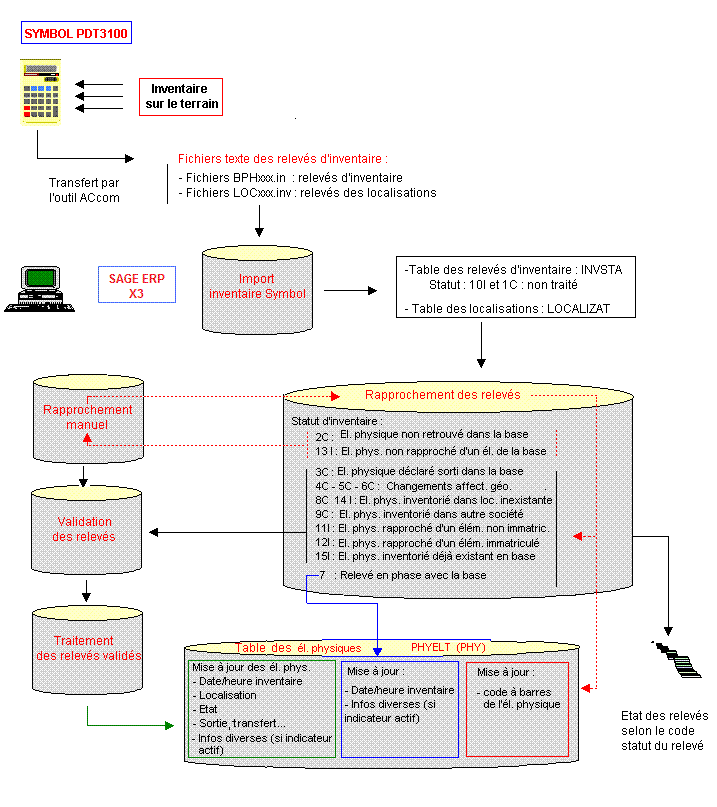Asset count sequence with the handheld device Symbol PDT3100
The goal of the asset count is to obtain a clear view of the physical elements actually present within the enterprise. It is therefore necessary to verify their existence, their location and to check that the information related to them found during the count is the same as that entered for the physical elements in the database.
The asset count necessitates the use of a dedicated tool (the Symbol PDT3100 portable terminal) whose principal functioning is based on a barcode-based registration number for the locations and the assets.
Setup
Using this tool requires a specific setup to be adapted to both the environment in which it will be used and the structure of the information to be collected.
This setup normally includes:
- the Locations(site/building/floor/room),
- the fields that are to be entered, their entry type, the authorized values etc....(Symbol dictionary PDT3100)
This information, used to define each Asset count operation, will be the object of an Exportin the form of text files transferred to the Symbol PDT3100 terminal via the ACcom tool.
Setup schema

Initial asset count
This first phase consists in listing the various physical elements.
This initial listing is carried out only for those physical elements were the barcode is absent, that is to say new physical elements, where the barcode is missing or the physical element that have not yet been registered. The Barcode for the asset must therefore be applied during the initial asset count listing.
This initial listing is used to recover, in addition to the physical element barcode, the location information (Site/Building/Floor/Room) as well as miscellaneous information such as thestatus, its serial n°…, information from which it will be possible to carryout a reconciliation with the physical elements in the database.
Control physical count
This type of asset count can only take place provided an initial asset count has already taken place. Its aim is to control the accuracy of the information contained in the asset file and to check the coherence between the contents of this file and the status of the property on the ground. It is only carried out for the assets where the barcode has already been applied. It recovers a certain number of items of information (defined at the level of the parameters) in order to check, extend or update the information in the database.
Import in Sage X3 of the collected information
Once the asset count is carried out, the lists carried out on the Symbol PDT3100 terminal are transferred using the ACcom tool, in the form of text files, in a dedicated Sage X3 directory in order to be imported into the location and asset count tables (Import asset count Symbol)
Processing of the information
TheAutomatic reconciliation of asset lists process carries out a comparison between the information in the lists obtained on the ground and the information recorded in the Sage X3 database to attempt to complete a reconciliation, as a function of the set up criteria, between the lists and the physical elements.
On completing the process, the status of the asset count list is modified and indicates the situation with respect to the Sage X3 database. Several situations may occur:
The list may match the database; in this case no update of the physical element is carried out: only the date/time and asset count status are revised for the physical element.
The physical element is not matched with an asset in the database ; in this case, it is necessary to proceed with a Manual reconciliation in order to assign the element to a barcode registration number, then to attempt to rerun an automatic reconciliation destined to check other information, notably the location of the physical element.
Variances are established between the information on the lists and those contained in the database. In this case, it is necessary to proceed
- first, with Asset count list validation process, in order to specify if the asset list situation found is exact and must be validated in order to be passed to the asset in the database or if it must be refused.
- second, with the Processing of validated lists. The refused asset lists are deleted, the assets will not be updated (with the exception of miscellaneous information set up at the level of the Symbol PDT3100, if the setut option is active). The validated asset lists will be taken into account and the processing will be carried out on the update of the financial assets from the asset list information. The update will be directlu carried out on the physical element whe it is not attached to an asset. When it is attached to an asset, any movement (except location change) will be put on hold at the asset level.
Schema for the import and the processing of the ABELX3 of the asset lists

